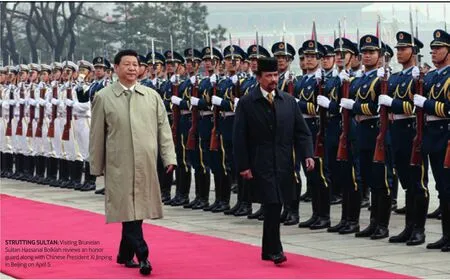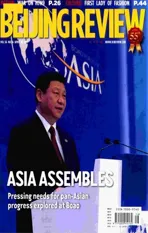Brunei’s Burden
2013-03-05ByJiangZhida
By Jiang Zhida
Brunei’s Burden
By Jiang Zhida
A small nation takes on a big challenge in shaping ASEAN
Brunei’s cardinal task as the ASEAN chair is to help
overcome the adverse external environment and
establish the ASEAN Economic Community on schedule

The author is an associate research fellow with the China Institute of International Studies
Brunei’s Sultan Hassanal Bolkiah paid a state visit to China in early April as the first foreign head of state Chinese President Xi Jinping has welcomed since taking office in the previous month. During the visit, the two countries agreed to upgrade their ties to a “strategic cooperative relationship.”
Brunei, which took over the rotating presidency of ASEAN from Cambodia at the beginning of this year, is confronted with a host of challenges. These include unprecedented political shifts in East Asia triggered by the U.S. pivot to the Asia Pacific and a much tougher situation for the establishment of an ASEAN Economic Community within the remaining two years.
Observers are watching closely how Brunei will help bridge differences within ASEAN, speed up the completion of the ASEAN Economic Community as well as the regional cooperation of East Asia, and maintain peace and stability in the South China Sea.
Coordination counts
ASEAN holds the driver’s seat in East Asian cooperation. Bruneian leaders have frequently visited ASEAN’s dialogue partners, especially China and the United States, to prepare for a series of East Asia summits in October amid increasing competition in the region between big countries. In February, Brunei’s Minister of Foreign Affairs and Trade Mohamed Bolkiah visited Beijing and exchanged views on bilateral relations and the summits. During Hassanal’s state visit, the top leaders of the two countries exchanged views on promoting China-ASEAN cooperation as well as the proper handling of the South China Sea issue.
China maintains that South China Sea disputes shall be peacefully resolved through bilateral consultation and friendly negotiation between directly concerned parties. Pending the final settlement of the disputes, China wishes to strengthen dialogue and communication with ASEAN nations to jointly safeguard peace and stability in the South China Sea. China objects to any factors that interfere with the process of friendly cooperation. Brunei called for making concerted efforts with all parties concerned to implement the Declaration on the Conduct of Parties in the South China Sea signed in 2002 and earnestly safeguard peace and stability in the region. The Bruneian sultan also claimed that the South China Sea issue should not become a barrier for the China-ASEAN friendship.
Before visiting China, Sultan Hassanal made a trip to Washington in March, during which he exchanged ideas with U.S. leaders on issues concerning the preparation of the October East Asia Summit and the U.S.-ASEAN Summit. Through the high-level visits, Brunei strengthened relations with the two major countries. At the same time, they helped boost the role of Brunei as the ASEAN chair and lay the groundwork for its future efforts to coordinate with big countries.
South China Sea priority
Due to the Philippines and Viet Nam insisting on including South China Sea disputes in the joint communiqué, the ASEAN Foreign Ministers’Meeting held last July for the first time in its history concluded without such a document, discouraging the ambitions of the two countries. However, backed by the United States and Japan, the Philippines and Viet Nam would not put the matter to rest. In January this year, the Philippines brought South China Sea disputes with China to a UN tribunal in an attempt to seek binding arbitration. Viet Nam is also eager to follow suit.
The United States, though claiming not to take sides in South China Sea disputes, sent aircraft carriers to the region last year in the name of protecting the freedom of navigation. But China holds that there is no navigation freedom problem in the region. At a press conference after meeting with Hassanal in March, U.S. President Barack Obama told reporters he will raise maritime territorial issues at the October East Asia Summit and the U.S.-ASEAN Summit.
With a series of diplomatic moves, Japan also attempts to take advantage of island disputes between China and some of ASEAN nations to contain China. During his visit to Brunei in January, Japanese Foreign Minister Fumio Kishida said both Japan and Brunei have territorial disputes with China and dealing with China is a common issue of both countries, statements that carry dubious motives. On March 14, the Japanese Government hosted a vice-ministerial level defense dialogue with ASEAN nations to discuss defense and security issues in the Asia Pacific in the hope of intimidating ASEAN nations to join the anti-China camp.

As a moderate ASEAN Muslim country, Brunei has always maintained a neutral position on the disputes, insisting on a peaceful resolution. Though Brunei is one of the South China Sea claimants, it has been a supporter of the principle of shelving disputes and pursuing joint development proposed by China. Last December, Brunei and Malaysia declined to attend a meeting of South China Sea claimants in ASEAN held by the Philippines. A new ASEAN chair customarily holds an unofficial meeting of ASEAN foreign ministers in January to have an open discussion on the major issues of the year. But fearing the South China Sea issue would again become the major topic, Brunei called off the meeting to avoid an adversarial stance with China.
Constrained by its own influence and limited resources, Brunei is unlikely to put forward proposals for resolving the South China Sea disputes. But by making the most of its neutral position, it can coordinate with and mediate between the parties, thus helping reach a compromise acceptable for all and promote progress in seeking a peaceful settlement. In order to minimize internal differences in ASEAN, Brunei will likely suggest that China quicken the formulation of a code of conduct in the South China Sea. It would do so on the basis of adhering to the consensus reached at the Phnom Penh summit last year, which opposes bringing the issue to the international arena. In the meantime, Brunei would also work together with other ASEAN members to restrain the provocative actions of Philippines and Viet Nam.
ASEAN integration
Against the backdrop of the worldwide economic downturn, with the United States and European countries mired in financial and debt crises, Brunei’s cardinal task as the ASEAN chair is to help overcome the adverse external environment and establish the ASEAN Economic Community on schedule. Though much progress has been made since 2012, the deadline for establishing the ASEAN Economic Community has been delayed for almost a year to the end of 2015 for a variety of reasons, such as the unbalanced development and divergent interests in ASEAN, fund shortages for infrastructure construction, as well as instability brought by South China Sea disputes.
Former ASEAN Secretary General Surin Pitsuwan pointed out that the major challenge for ASEAN would be whether its member states have the willingness to deepen regional integration. To what extent ASEAN nations will narrow their differences this year will be essential to ASEAN integration as well as the integration of East Asia led by ASEAN.
ASEAN has its own advantages. As labor costs in the Chinese market rapidly increase, many overseas-funded enterprises have begun to withdraw from China’s mainland. Meanwhile, the demographic dividend of ASEAN nations is becoming increasingly attractive to foreign investors. Statistics show that foreign direct investment in ASEAN nations reached $117 billion in 2012, $1 billion more than foreign investment to China. Moreover, with the spillover effect of the Chinese economy, the Chinese market has become a powerful engine driving the export of ASEAN nations, laying a solid foreign trade foundation for ASEAN economic development.
The outside world is optimistic about ASEAN’s economic growth. The International Monetary Fund has estimated that the growth rate of five ASEAN members—Indonesia, Malaysia, Thailand, the Philippines and Viet Nam—will reach 5.8 percent in 2013. In its Southeast Asian Economic Outlook 2013 report, the Organization for Economic Cooperation and Development forecasted that the six major ASEAN countries—Indonesia, Malaysia, Thailand, Singapore, the Philippines and Viet Nam—will post an average economic growth rate of 6 percent in the next five-year period. At an unofficial meeting of ASEAN economic ministers in March, they reiterated their commitment to the establishment of the ASEAN Economic Community by 2015. They also passed documents and proposals on promoting regional economic integration.
As Brunei lives up to its role as ASEAN’s rotating chair, 2013 is a year presenting both challenges and opportunities. It offers a good chance for the country to display leadership.
yanwei@bjreview.com
